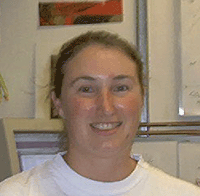Interactions of YopE with the Rho GTPase family
Sara Birtalan
Appointment Period: 2001-2003, Grant Years: [17,18]
 Pseudomonas aeruginosa is important in the treatment of cancerthrough the use of the Exotoxin A fused to a variety of different proteins soas to target cytotoxicity specifically to tumor cells. This has been accomplished by others through the use of chimeric Exotoxin A fusions with proteins such as granulocyte colony-stimulating factor (G-CSF), luteinizing hormone releasing hormone, transforming growth factor (TGF)-alpha, Interleukin-4, Interleukin-13, and others. In addition, acting as an infectious agent in its own right, Pseudomonas aeruginosa causes severe and often deadly infections in cancer patients. Treatment of infection by P. aeruginosa isoften difficult due to the resistance of this pathogen to antibiotics. Certainclinical isolates of P. aeruginosaare cytotoxic due to the production of the 74 kDa protein toxin ExoU. My current research involves understanding how ExoU becomes activated inside the host cell, an area which could potentially lead to new therapies in protecting cells from the ExoU toxin. In summary, this work will provide greater insight into the mechanisms of cytotoxicity by P.aeruginosa, acting through multiple toxins, including Exo U and Exotoxin A. In addition, this work will expand our knowledge of the use of Pseudomonas toxins as a means of cytotoxic targeting of human tumor cells.
Pseudomonas aeruginosa is important in the treatment of cancerthrough the use of the Exotoxin A fused to a variety of different proteins soas to target cytotoxicity specifically to tumor cells. This has been accomplished by others through the use of chimeric Exotoxin A fusions with proteins such as granulocyte colony-stimulating factor (G-CSF), luteinizing hormone releasing hormone, transforming growth factor (TGF)-alpha, Interleukin-4, Interleukin-13, and others. In addition, acting as an infectious agent in its own right, Pseudomonas aeruginosa causes severe and often deadly infections in cancer patients. Treatment of infection by P. aeruginosa isoften difficult due to the resistance of this pathogen to antibiotics. Certainclinical isolates of P. aeruginosaare cytotoxic due to the production of the 74 kDa protein toxin ExoU. My current research involves understanding how ExoU becomes activated inside the host cell, an area which could potentially lead to new therapies in protecting cells from the ExoU toxin. In summary, this work will provide greater insight into the mechanisms of cytotoxicity by P.aeruginosa, acting through multiple toxins, including Exo U and Exotoxin A. In addition, this work will expand our knowledge of the use of Pseudomonas toxins as a means of cytotoxic targeting of human tumor cells.
Birtalan SC, Phillips RM, Ghosh P. 2002.Three-dimensional secretion signals in chaperone-effector complexes of bacterial pathogens. Mol. Cell (2002)9:971-80.
 Pseudomonas aeruginosa is important in the treatment of cancerthrough the use of the Exotoxin A fused to a variety of different proteins soas to target cytotoxicity specifically to tumor cells. This has been accomplished by others through the use of chimeric Exotoxin A fusions with proteins such as granulocyte colony-stimulating factor (G-CSF), luteinizing hormone releasing hormone, transforming growth factor (TGF)-alpha, Interleukin-4, Interleukin-13, and others. In addition, acting as an infectious agent in its own right, Pseudomonas aeruginosa causes severe and often deadly infections in cancer patients. Treatment of infection by P. aeruginosa isoften difficult due to the resistance of this pathogen to antibiotics. Certainclinical isolates of P. aeruginosaare cytotoxic due to the production of the 74 kDa protein toxin ExoU. My current research involves understanding how ExoU becomes activated inside the host cell, an area which could potentially lead to new therapies in protecting cells from the ExoU toxin. In summary, this work will provide greater insight into the mechanisms of cytotoxicity by P.aeruginosa, acting through multiple toxins, including Exo U and Exotoxin A. In addition, this work will expand our knowledge of the use of Pseudomonas toxins as a means of cytotoxic targeting of human tumor cells.
Pseudomonas aeruginosa is important in the treatment of cancerthrough the use of the Exotoxin A fused to a variety of different proteins soas to target cytotoxicity specifically to tumor cells. This has been accomplished by others through the use of chimeric Exotoxin A fusions with proteins such as granulocyte colony-stimulating factor (G-CSF), luteinizing hormone releasing hormone, transforming growth factor (TGF)-alpha, Interleukin-4, Interleukin-13, and others. In addition, acting as an infectious agent in its own right, Pseudomonas aeruginosa causes severe and often deadly infections in cancer patients. Treatment of infection by P. aeruginosa isoften difficult due to the resistance of this pathogen to antibiotics. Certainclinical isolates of P. aeruginosaare cytotoxic due to the production of the 74 kDa protein toxin ExoU. My current research involves understanding how ExoU becomes activated inside the host cell, an area which could potentially lead to new therapies in protecting cells from the ExoU toxin. In summary, this work will provide greater insight into the mechanisms of cytotoxicity by P.aeruginosa, acting through multiple toxins, including Exo U and Exotoxin A. In addition, this work will expand our knowledge of the use of Pseudomonas toxins as a means of cytotoxic targeting of human tumor cells.